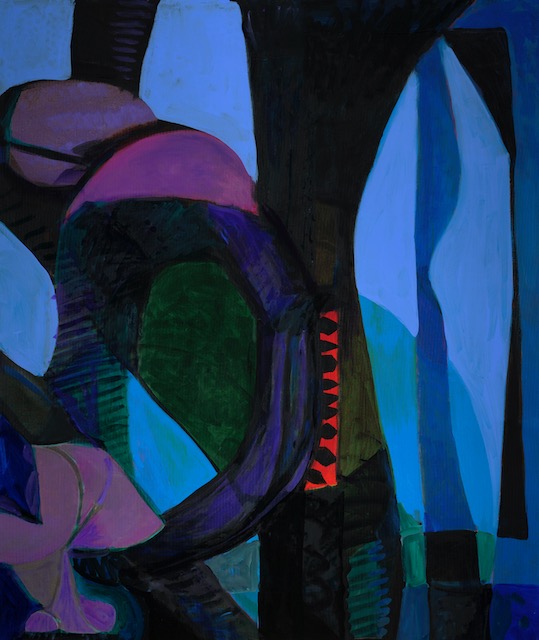
MIDNIGHT LINE, oil and acrylic on canvas, 47.5 x 40 inches, 2017
by Dorothy Barenscott Ph.D.
Art History Faculty, Fine Arts Department
Kwantlen Polytechnic University
Stepping into Tiko Kerr’s studio is like passing a threshold into a space of perpetual exploration and creativity. Paints, pigments, pencils, tools, and books spill out and occupy all available shelves and surfaces, while carefully and not-so-carefully composed drawings, collages, pictures, photos, and canvases—endless rows and stacks of sensuously painted gigantic canvases of bold and mostly abstract forms—line the walls. “We are visually malnourished,” offers Kerr, as I look around and take in the awesomeness of the space. When people visit his studio for the first time, they often react most strongly to the sheer expressive drive and flowing creativity that an artist’s studio activates in visitor and artist alike. Unlike the screen culture that animates most of our visual discourse today, a culture that operates at a cool and calculated remove from the messiness of real life, an artist’s studio reveals the seams and underpinnings—the labour-intensive working-through process—that goes into the production of visual art. The experience of visiting a studio, often very bodily and emotional for the visitor, reminds and connects us to a very primal part of who we all are. “When people see my work, they often say, ‘I wish I had that kind of freedom,’” explains Kerr.
Freedom is at the nexus of Tiko Kerr’s practice, and one of the first things to learn about Kerr as a contemporary artist is that he is completely self-taught. As a child, he spent countless hours drawing on the blackboard after school while waiting for his mother, a teacher, to complete her grading. Kerr describes how he would fill a brush with chalk and create patterns and volumes through a method of instinctive experimentation and mark making. Later, as a young adult, he dreamed of becoming a doctor, but while on a gap year before college, he ended up extending his travels around the world for a full six years. During that period, he refined the critical discipline of daily sketching and drawing while visiting the world’s most important art museums—a rare form of self-education that many trained artists today could only dream of pursuing. Kerr’s travels eventually brought him back to his hometown of Calgary for his first two-man art exhibition, and then in the late 1980s on to Vancouver, where he learned more about acrylic painting and began his active participation in the city’s vibrant commercial gallery scene. Every show, says Kerr, was a new experiment.
Art history is necessarily replete with narratives about self-taught artists, stories with a tendency toward romanticism and clichéd melodramatic accounts of the “artist-genius.” Turning to biographies of Jackson Pollock, Vincent van Gogh, or Francis Bacon, for example, these are stories that mostly work to seduce us or position the artist for the strategic aims of art history’s overarching grand narrative. Importantly, however, stories of the self-taught artist also feed our collective contemporary desire for signs of authenticity. In a world where notions of the real are increasingly slippery, the self-taught artist fills an important void. As sociologist Gary Alan Fine argues in his study of outsider artists, at the core of our obsession with this category of producer is a yearning to understand individual drive: “Ultimately self-taught art is a form of identity art in which the characteristics of the creators matter as much as the characteristics of the work.”